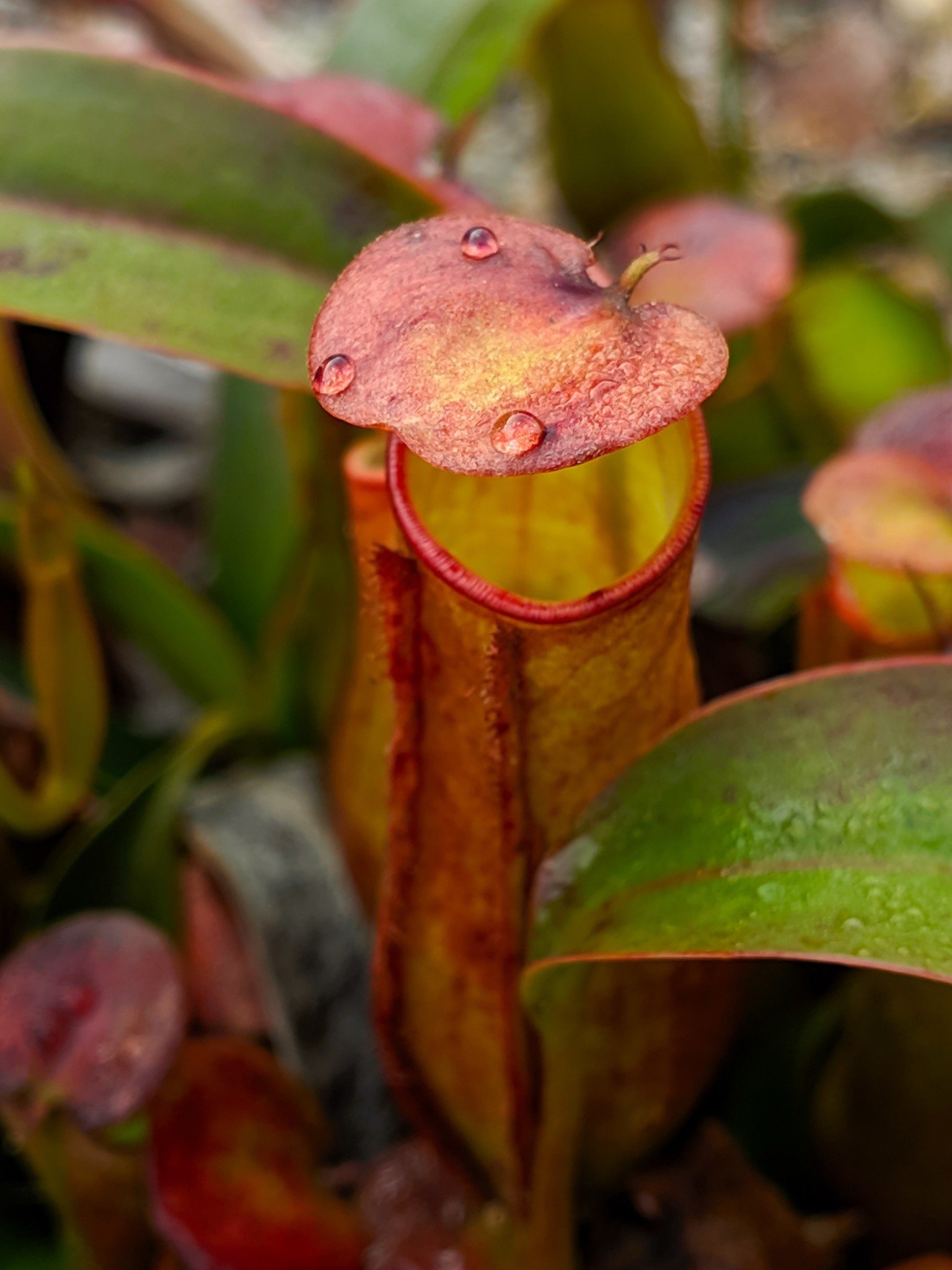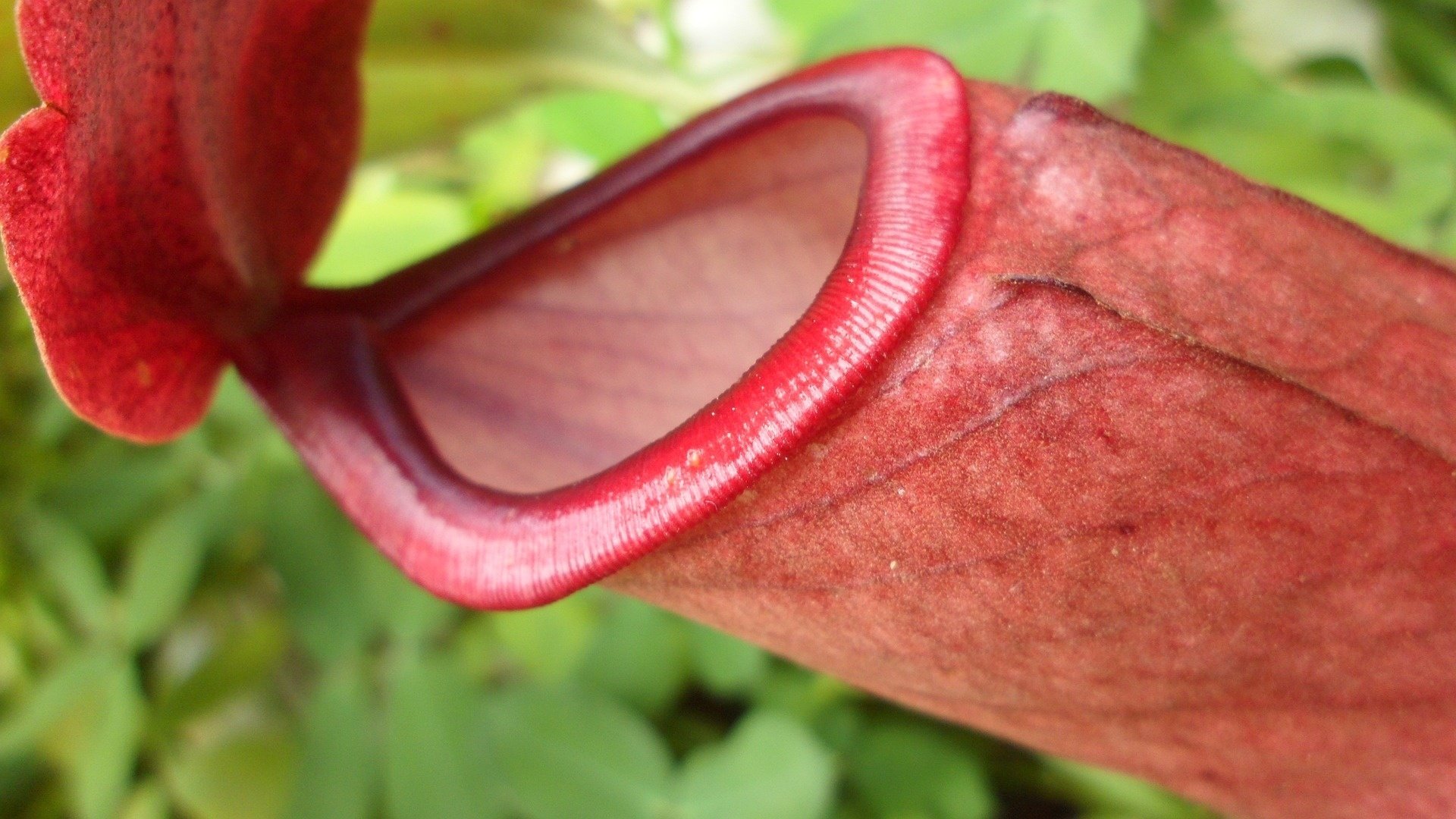
In our comprehensive text, we go into detail on what you need to know about care, ideal growing conditions to nutrition, pruning and so much more
The pitcher plant, also known as the Nepenthes, is a beautifulexotic carnivorous plant. The unique cup-shaped traps along with the striking leaves are characteristic of the Nephentes. This therefore makes the Nepenthes an exceptional addition to any plant collection.
The best growing conditions for the Nepenthes
We all know the pitcher plant as an exotic jungle plant that originated in Southeast Asia, Madagascar and Australia. Incidentally, this is important to know when you want to provide your plant with the best growing conditions. After all, you want to recreate its natural environment as precisely as possible.
- Light: the most important thing for any Nepenthes is a
 lot of indirect light. This is where the pitcher plant grows best. The key for Nepenthes is to place it near an east or west-facing window so that it gets at least 6 to 8 hours of filtered sunlight a day. Why can't a Nepenthes be placed in direct sunlight? Direct sunlight can burn the leaves of the pitcher plant. So it is extremely important to avoid this. The same applies to this plant as to all other carnivorous plants. If you cannot offer the plant enough natural light, it is wise to look at an LED grow light.
lot of indirect light. This is where the pitcher plant grows best. The key for Nepenthes is to place it near an east or west-facing window so that it gets at least 6 to 8 hours of filtered sunlight a day. Why can't a Nepenthes be placed in direct sunlight? Direct sunlight can burn the leaves of the pitcher plant. So it is extremely important to avoid this. The same applies to this plant as to all other carnivorous plants. If you cannot offer the plant enough natural light, it is wise to look at an LED grow light. - Temperature: The optimal temperature for a Nepenthes is between 21 and 29 degrees Celsius. For these plants, it is important to make sure the temperature does not drop below 16 degrees Celsius. This can actually stunt growth, and the plant can also easily become susceptible to diseases. Choose a location away from draughty places, such as open windows and doors, but also a radiator. These factors can cause the temperature to fluctuate a lot.
- Humidity: As pitcher plants originate from the jungle, it is important that they have a constant and high supply of humidity. For a pitcher plant, it is important that the humidity is and stays between 60% and 80%. Should it not be possible to create this, a humidifier is a fantastic solution. In addition, you can always choose to put your pitcher plant in a saucer with water. Just make sure the pot has holes so the water can flow freely. Another option and this is really for the die hard hobbyists is a carnivorous plant terrarium. Here, moisture control is a lot easier to control.
- Potting soil: Carnivorous plants are extremely fussy when it comes to potting soil. After all, they live in the wild on acidic soil, which is what they really need. We therefore recommend using a mix of 50% peat and 50% perlite. This keeps the soil airy, which is extremely important for your Nepenthes.
How much water does my Nepenthes need?
Water is extremely important for pitcher plants, but it is important to know how to water them properly:
- Water quality: All Carnivorous plants should only have rainwater, demineralised water or distilled water. Tap water contains minerals and chemicals that can be harmful to the plant.
- Watering: The pitcher plant needs only slightly moist potting soil. Make sure not to soak the potting soil, as this can lead to root rot and the growth of harmful fungi. How can you easily keep an eye on this? Water the plant when the top 2.5 cm of the potting soil starts to dry out.
- Fill cups with water: We drain the cups before transport. We do this to ensure that the shipment remains intact. Therefore, upon receipt, please let the cups fill 1/4th full once, preferably with rainwater.
What does my Nepenthes eat?
In general, the Nepenthes only needs a little bit of nutrition. This nutrition is obtained from the insects which fall into the cups of the Nepenthes. Hence the name carnivorous plant. Do you want to know whether your carnivorous plant needs extra nutrition besides its captured or given food? Then read our blog.
- Catches insects by itself: As we just mentioned, the carnivorous plant gets its nutrients from the insects it catches. These are converted by the Nepenthes to grow and survive.
- Hand feeding: Only do this when your plants do not have access to insects. In this case, however, it is extremely important that you do not touch any leaves or the inside of the cups. You can damage the plant with this. In this case, drop an insect in the middle of the cup using policy and tweezers. Do not feed the plant anything extra. The plant does not need this and may even do more damage than good.
How do I keep my Nepenthes healthy?
It is important for a Nepenthes to be pruned and maintained regularly. This makes the little plant feel at its best at all times, which also helps it grow. We have a few tips for you to best maintain your Nepenthes:
Remove only dead or diseased leaves: It is important to check your Nepenthes regularly for dead or diseased leaves. When you remove these, you help the plant to put its energy back into growing. Pay attention to the following two important things when pruning:
- Only use clean tools to prune your plantlet, as this can prevent some infections.
In addition, cut or trim as close to the base of the plant as possible to avoid any complications.
Remove old cups: Cups of a Nepenthes deteriorate in time especially if they actively catch insects. Be extremely careful when removing the old cups, cut them off only with clean and sharp pruning shears.
Offer your plant support: Of course you want your Nepenthes to grow. However, the Nepenthes has quite a few (heavy) cups hanging from it. To prevent your Nepenthes from falling over and possibly damaging its cups, it is wise to use a bamboo stick or a plant support to give your Nepenthes support.
Repotting your Nepenthes: Carnivorous plants need to be repotted every few years. They need this to promote healthy growth. Choose a pot that is only slightly larger than the pot the plant is currently in. For repotting, again use 50% peat and 50% perlite It is best to repot your carnivorous plant in spring, when the carnivorous plants are actively growing.
Common problems and solutions for the Nepenthes
It is quite natural for carnivorous plants, like any other plant, to suffer from diseases. We have therefore listed some common problems and solutions for you:
- No cups forming: This can occur in a Nepenthes when they have
 insufficient light, too low humidity or a nutrient deficiency. You can already solve this simply by looking at the routine you apply. Move the pitcher plant so it still gets enough light and moisture. If necessary, go for another humidifier if needed. As for feeding, if there really is no other way, consider giving the Nepenthes an extra bug.
insufficient light, too low humidity or a nutrient deficiency. You can already solve this simply by looking at the routine you apply. Move the pitcher plant so it still gets enough light and moisture. If necessary, go for another humidifier if needed. As for feeding, if there really is no other way, consider giving the Nepenthes an extra bug. - Yellow or brown leaves: In the Nepenthes, this can indicate too much direct sunlight, too much watering or perhaps incorrect water quality. How to solve this is by moving the Nepenthes to an area with more indirect light, keep the soil moist only and don't soak it and for watering use only rainwater, demineralised water or distilled water. There is also a possibility of the Nepenthes' traps turning black, what is the best way to solve this? Read our blog on this topic.
- Fungi or diseases: You can quickly prevent fungal growth in carnivorous plants with the amount of water you give the plant. It is also key to keep the humidity level up. Just keeping the soil moist and not soaking it prevents moulds. Regularly check your carnivorous plant for signs of mould, aphids, mites or other infestations, and treatyour carnivorous plant if necessary. You can do this by putting your plant under water, wiping off the aphids with a brush or, if this does not work, spraying it with washing-up liquid. However, this is a last resort option. If you now know all about carnivorous plants and want to buy your (first) carnivorous plant, take a look at our Nepenthes Bloody Mary.
Conclusion
We at Carnivory.eu agree that keeping a carnivorous plant like the Nepenthes is an extremely fascinating hobby. Especially when you can give your pitcher plant the optimal living conditions, you will see a happy and beautiful plant grow and bloom, which you in turn can enjoy immensely.
So we would like to share this hobby with everyone. If you have always wanted a Nepenthes, be sure to have a look at our assortment.


